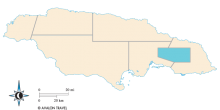Coffee is one of 600 species in the Rubiaceae family, understood to have its center of origin in what is today Ethiopia. The plant's beans and leaves are believed to have been chewed by the earliest inhabitants of the region and later brewed by ancient Abyssinians and Arabs, the latter credited with originating the global coffee trade.
Jamaica's relationship with the revered bean dates to 1728 when a former governor, Nicholas Lawes, introduced coffee of the Typica variety to his Temple Hall estate just past Stony Hill in upper St. Andrew. Its cultivation was formalized in earnest with large plantations covering hundreds of acres established in the nearby Blue Mountains by an influx of planters fleeing Haiti in the years leading up to the neighboring country's 1804 independence. By 1800, there were 686 coffee plantations in Jamaica, with exports totaling 15,199 tons, according to Jamaica's Coffee Industry Board (CIB). These early planters discovered that the intact plantation economy and the cloud forest climatic conditions were conducive to lucrative coffee production. The misty climate allowed the coffee berries to ripen slowly, a process said to grant the end product its smooth, full-bodied flavor, free of bitterness. The bumper earnings of these early plantations were short-lived, however, deteriorating when global demand subsided and competition from other colonies imposing a smaller coffee tax increased. The abolition of slavery and emancipation further challenged Jamaica's large-scale coffee plantations; when labor became scarce, the country's production deteriorated and the bean's cultivation was soon dominated by smallholders. By 1850 there were only 186 plantations left in Jamaica, with exports falling to 1,486 tons, according to CIB records.
Jamaica's Coffee Industry Board, established in 1950, was set up to control the quality of Jamaica's coffee product and participate directly in the production process. Two government-owned processing plants, Mavis Bank Coffee Factory and Wallenford Coffee Company, operate under its wing. The beans are supplied by their own farms and by thousands of small-scale growers. The CIB also regulates the coveted Blue Mountain Coffee registered trademark, allowing only farms certified by the board in the parishes of St. Andrew, St. Thomas, Portland, and St. Mary, all located at an elevation between 2,000 and 5,000 feet, to use the name. Wallenford and Mavis Bank Coffee Factory produce a large portion of Jamaica's export crop, around 80 percent of which is sent to Japan. Mavis Bank Coffee Factory commercializes a line of finished products under the JABLUM brand. Government equity in both entities is understood to have been on the block for years, even while some private coffee estates, most notably Craighton, have changed hands.
Obtaining a certification by the CIB as a producer of Blue Mountain Coffee is a challenge, especially for small farmers trying to earn a living off their farms. It can take several years, as certification demands scrupulous adherence to and implantation of the farming practices and production processes sanctioned by the CIB.
Jamaican coffee produced at lower elevations can also be of high quality, even it doesn't attract the same attention or price as Blue Mountain Coffee. Jamaica Prime, Premium Washed, and High Mountain Supreme are some of the names Jamaican coffee has sold under when not originating from the Blue Mountains. There are notable coffee producers in several parishes around Jamaica, among them farms in Bog Walk and St. Catherine, at Key Park Estate in Westmoreland, at Aenon Park along the Clarendon/St. Ann border, at Clarendon Park, and in Maggoty, in St. Elizabeth.
Jamaica's climate is at once a blessing and a curse for the country's coffee farmers. It's the high altitude mist cover that nurtures the bean to give it its distinct character, but the country's highest peaks are also most exposed and vulnerable to hurricanes and tropical storms, which can destroy several years' work in one night. The lack of insurance for the industry since Hurricane Ivan in 2004 has made production at many small farms a real gamble. Combating disease is also a constant struggle for Jamaica's coffee farmers. Nonetheless, today's coffee industry employees some 50,000 Jamaicans and brings in around US$35 million in foreign exchange each year. Retailing at around US$30 per pound in Jamaica and around US$50 per pound in North America and Europe, Jamaica Blue Mountain Coffee continues to fetch a high price, which is one of the few reasons Jamaica's coffee industry, as a whole, remains viable.










